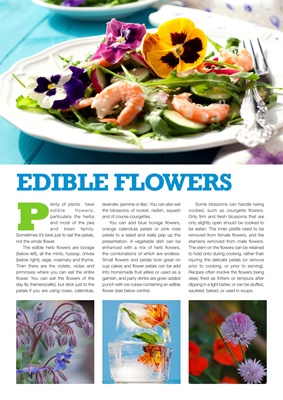
LIVINGLIVING
EDIBLE FLOWERS
Plenty of plants have
edible flowers,
particularly the herbs
and most of the pea
and bean family.
Sometimes it's best just to eat the petals,
not the whole flower.
The edible herb flowers are borage
(below left), all the mints, hyssop, chives
(below right), sage, rosemary and thyme.
Then there are the violets, violas and
primroses where you can eat the entire
flower. You can eat the flowers of the
day lily (hemerocallis), but stick just to the
petals if you are using roses, calendula,
lavender, jasmine or lilac. You can also eat
the blossoms of rocket, radish, squash
and of course courgettes.
You can add blue borage flowers,
orange calendula petals or pink rose
petals to a salad and really pep up the
presentation. A vegetable dish can be
enhanced with a mix of herb flowers,
the combinations of which are endless.
Small flowers and petals look great on
cup cakes and flower petals can be add
into homemade fruit jellies or used as a
garnish, and party drinks are given added
punch with ice cubes containing an edible
flower (see below centre).
Some blossoms can handle being
cooked, such as courgette flowers.
Only firm and fresh blossoms that are
only slightly open should be cooked to
be eaten. The inner pistills need to be
removed from female flowers, and the
stamens removed from male flowers.
The stem on the flowers can be retained
to hold onto during cooking, rather than
injuring the delicate petals (or remove
prior to cooking, or prior to serving).
Recipes often involve the flowers being
deep fried as fritters or tempura after
dipping in a light batter, or can be stuffed,
sautéed, baked, or used in soups.